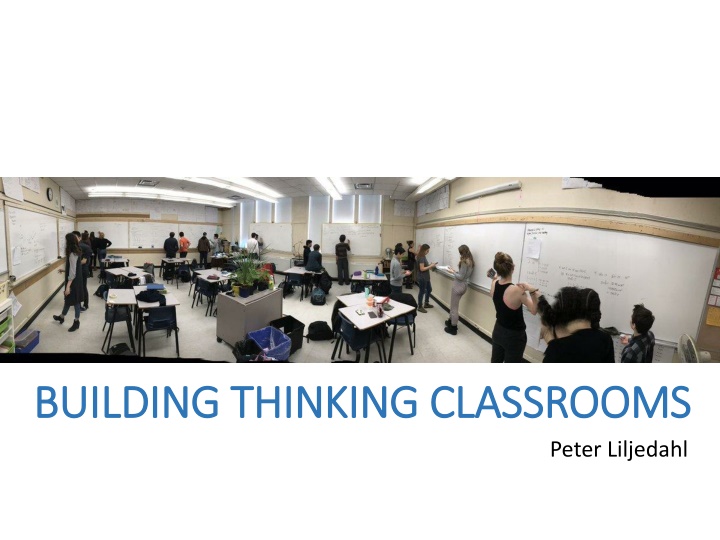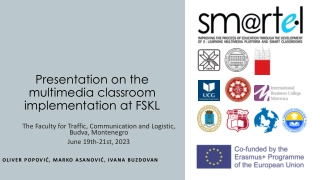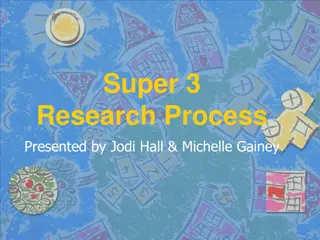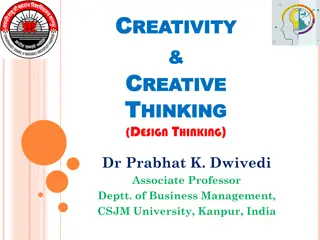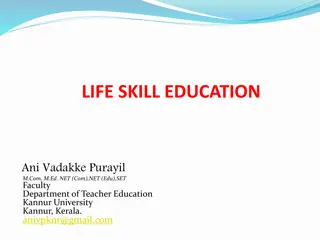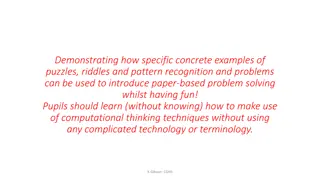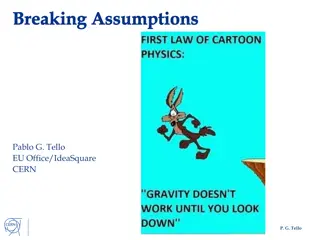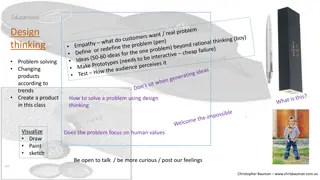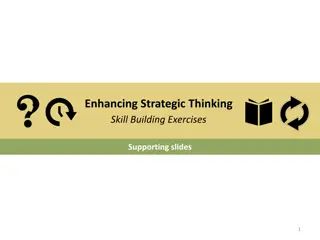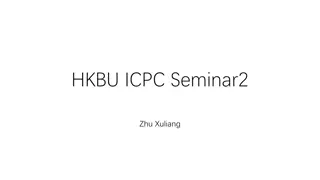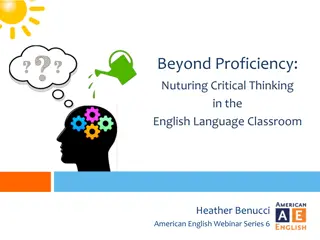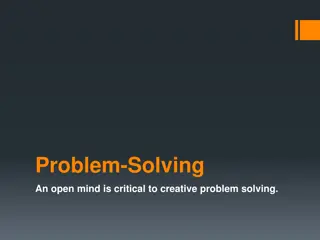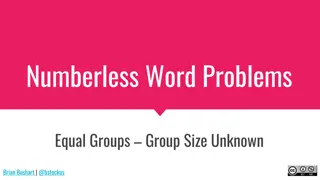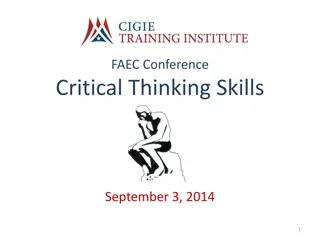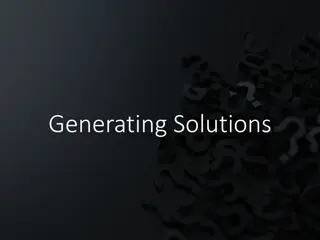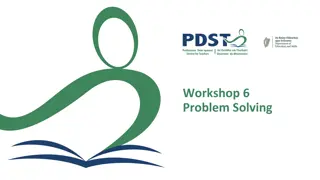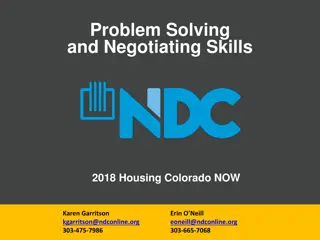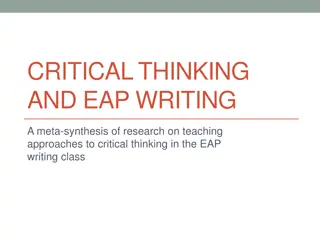Building Thinking Classrooms: Enhancing Problem-Solving Skills
Strategies by Peter Liljedahl to create a conducive learning environment in mathematics classrooms, focusing on engaging students in problem-solving, group dynamics, and effective assessment. Discover the impact of using visibly random groups and fostering student autonomy through a hierarchy of implementation.
Uploaded on Feb 25, 2025 | 1 Views
Download Presentation

Please find below an Image/Link to download the presentation.
The content on the website is provided AS IS for your information and personal use only. It may not be sold, licensed, or shared on other websites without obtaining consent from the author.If you encounter any issues during the download, it is possible that the publisher has removed the file from their server.
You are allowed to download the files provided on this website for personal or commercial use, subject to the condition that they are used lawfully. All files are the property of their respective owners.
The content on the website is provided AS IS for your information and personal use only. It may not be sold, licensed, or shared on other websites without obtaining consent from the author.
E N D
Presentation Transcript
BUILDING THINKING CLASSROOMS BUILDING THINKING CLASSROOMS Peter Liljedahl
www.peterliljedahl.com/presentations liljedahl@sfu.ca @pgliljedahl
Liljedahl, P. (2014). The affordances of using visibly random groups in a mathematics classroom. In Y. Li, E. Silver, & S. Li (eds.), Transforming Mathematics Instruction: Multiple Approaches and Practices. (pp. 127-144). New York, NY: Springer. Liljedahl, P. (2016). Building thinking classrooms: Conditions for problem solving. In P. Felmer, J. Kilpatrick, & E. Pekhonen (eds.), Posing and Solving Mathematical Problems: Advances and New Perspectives. (pp. 361-386). New York, NY: Springer. Liljedahl, P. (2016). Flow: A Framework for Discussing Teaching. Proceedings of the 40th Conference of the International Group for the Psychology of Mathematics Education, Szeged, Hungary. Liljedahl, P. (2017). Building Thinking Classrooms: A Story of Teacher Professional Development. The 1st International Forum on Professional Development for Teachers. Seoul, Korea. Liljedahl, P. (in press). On the edges of flow: Student problem solving behavior. In S. Carreira, N. Amado, & K. Jones (eds.), Broadening the scope of research on mathematical problem solving: A focus on technology, creativity and affect. New York, NY: Springer. Liljedahl, P. (in press). On the edges of flow: Student engagement in problem solving. Proceedings of the 10th Congress of the European Society for Research in Mathematics Education. Dublin, Ireland. Liljedahl, P. (in press). Building thinking classrooms. In A. Kajander, J. Holm, & E. Chernoff (eds.) Teaching and learning secondary school mathematics: Canadian perspectives in an international context. New York, NY: Springer.
VARIABLE problems how we give the problem how we answer questions room organization how groups are formed student work space autonomy how we give notes hints and extensions how we level assessment
VARIABLE POSITIVE EFFECT problems begin with good problems how we give the problem oral vs. written how we answer questions 3 types of questions room organization defront the room how groups are formed visibly random groups student work space vertical non-permanent surfaces autonomy create space and push them into it how we give notes use mindful notes hints and extensions managing flow how we level level to the bottom assessment 4 purposes
HIERARCHY OF IMPLEMENTATION
begin with good problems use vertical non- permanent surfaces form visibly random groups
use oral instructions defront the classroom answer only keep thinking questions build autonomy
level to the bottom use hints and extensions to manage flow use mindful notes use 4 purposes of assessment
HIERARCHY OF IMPLEMENTATION
PROXIES FOR ENGAGEMENT time to task time to first mathematical notation amount of discussion eagerness to start participation persistence knowledge mobility non-linearity of work 0 - 3
vertical non-perm horizontal non-perm vertical permanent horizontal permanent notebook N (groups) 10 10 9 9 8 time to task 12.8 sec 13.2 sec 12.1 sec 14.1 sec 13.0 sec first notation 20.3 sec 23.5 sec 2.4 min 2.1 min 18.2 sec discussion 2.8 2.2 1.5 1.1 0.6 eagerness 3.0 2.3 1.2 1.0 0.9 participation 2.8 2.3 1.8 1.6 0.9 persistence 2.6 2.6 1.8 1.9 1.9 mobility 2.5 1.2 2.0 1.3 1.2 non-linearity 2.7 2.9 1.0 1.1 0.8
vertical non-perm horizontal non-perm vertical permanent horizontal permanent notebook N (groups) 10 10 9 9 8 time to task 12.8 sec 13.2 sec 12.1 sec 14.1 sec 13.0 sec first notation 20.3 sec 23.5 sec 2.4 min 2.1 min 18.2 sec discussion 2.8 2.2 1.5 1.1 0.6 eagerness 3.0 2.3 1.2 1.0 0.9 participation 2.8 2.3 1.8 1.6 0.9 persistence 2.6 2.6 1.8 1.9 1.9 mobility 2.5 1.2 2.0 1.3 1.2 non-linearity 2.7 2.9 1.0 1.1 0.8
vertical non-perm horizontal non-perm vertical permanent horizontal permanent notebook N (groups) 10 10 9 9 8 time to task 12.8 sec 13.2 sec 12.1 sec 14.1 sec 13.0 sec first notation 20.3 sec 23.5 sec 2.4 min 2.1 min 18.2 sec discussion 2.8 2.2 1.5 1.1 0.6 eagerness 3.0 2.3 1.2 1.0 0.9 participation 2.8 2.3 1.8 1.6 0.9 persistence 2.6 2.6 1.8 1.9 1.9 mobility 2.5 1.2 2.0 1.3 1.2 non-linearity 2.7 2.9 1.0 1.1 0.8
vertical non-perm horizontal non-perm vertical permanent horizontal permanent notebook N (groups) 10 10 9 9 8 time to task 12.8 sec 13.2 sec 12.1 sec 14.1 sec 13.0 sec first notation 20.3 sec 23.5 sec 2.4 min 2.1 min 18.2 sec discussion 2.8 2.2 1.5 1.1 0.6 eagerness 3.0 2.3 1.2 1.0 0.9 participation 2.8 2.3 1.8 1.6 0.9 persistence 2.6 2.6 1.8 1.9 1.9 mobility 2.5 1.2 2.0 1.3 1.2 non-linearity 2.7 2.9 1.0 1.1 0.8
students become agreeable to work in any group they are placed in there is an elimination of social barriers within the classroom mobility of knowledge between students increases reliance on co-constructed intra- and inter-group answers increases reliance on the teacher for answers decreases engagement in classroom tasks increase students become more enthusiastic about mathematics class
TAKE NOTES don t keep up n=16 don t n=3 keep up n=11 yes n=3 don t use notes n=27 USE NOTES TO STUDY TAKING NOTES
TAKE NOTES don t keep up n=16 don t n=3 keep up n=11 yes n=3 don t use notes n=27 USE NOTES TO STUDY TAKING NOTES
THANK YOU! liljedahl@sfu.ca www.peterliljedahl.com/presentations @pgliljedahl | #vnps | #thinkingclassroom Global Math Department
